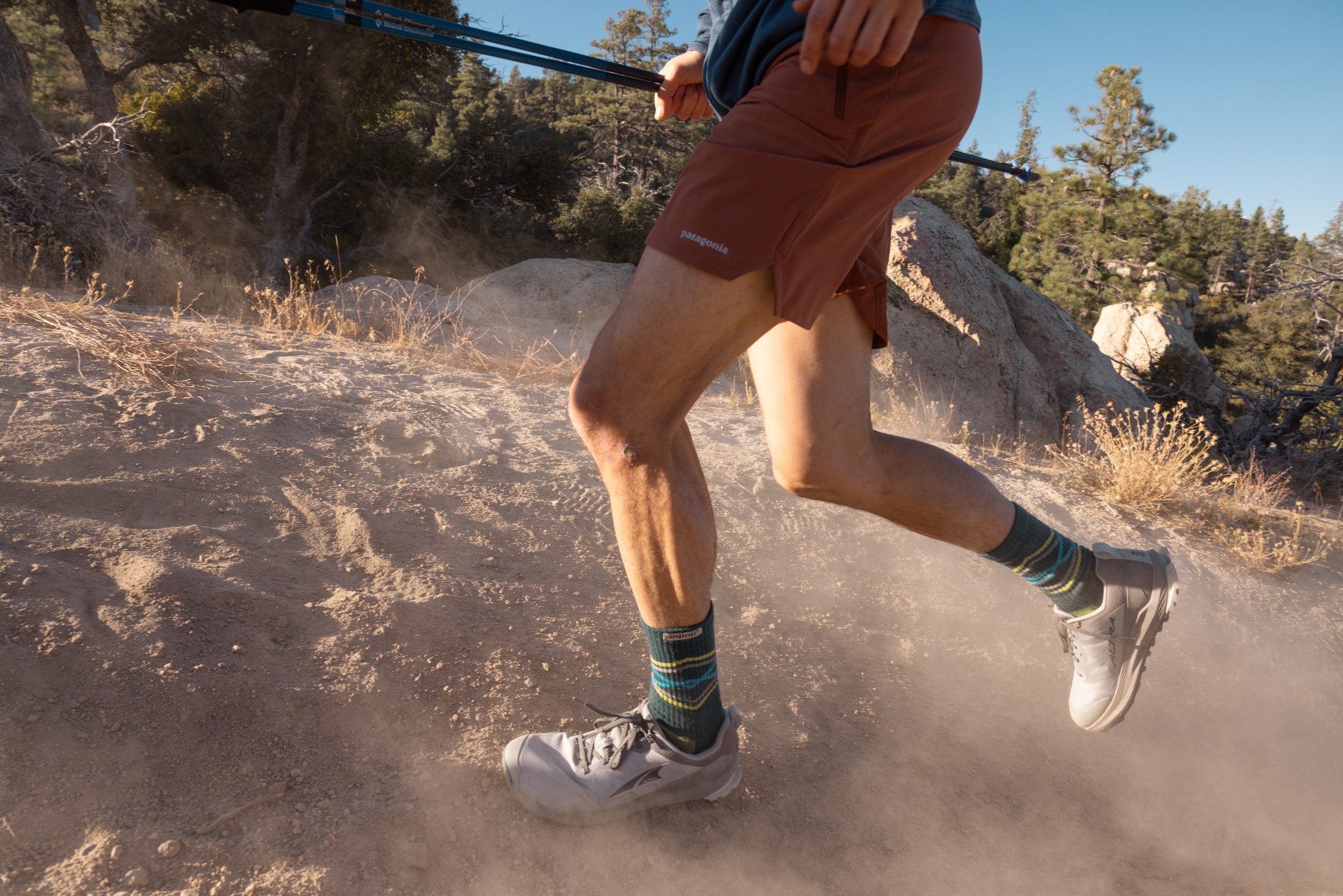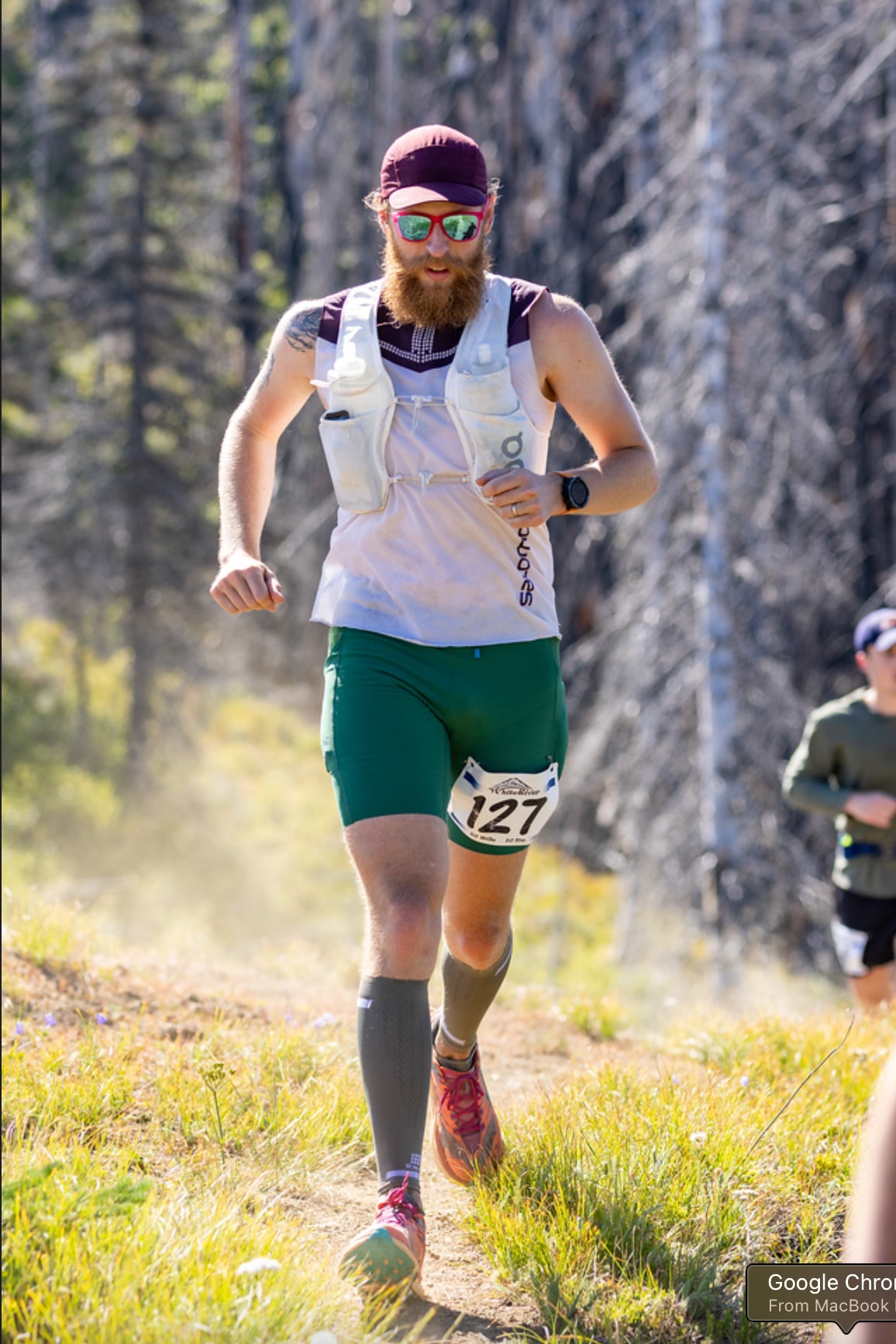Nothing beats the peaceful yet exhilarating experience of trail running, whether it’s a loop at a local park or a multi-hour adventure above treeline. But before you head for the hills, you need the right footwear. Your go-to road-running trainers might be able handle a less technical trail every now and then, like a park path or frontage road, but there’s no substitute for trail-running shoes to keep your feet comfortable, stable and protected when the pavement ends and dirt begins.
While they have much in common with their pavement-pounding relatives, trail-running shoes differ from road-running shoes in significant ways:
Traction: Trail-running shoes have grippy lugs on their outsoles (the bottoms of the shoes) to help you find more stable footing while moving over loose dirt, mud, gravel, tree roots and rock slabs.
Protection: From the upper (the top of the shoe, including tongue and laces) to the outsole, trail-running shoes incorporate features meant to protect your feet from rough terrain. More durable materials and design like rubber toe caps and plastic or carbon plates in the midsole ensure you can withstand rocks, sticks, and other debris you may encounter on trail.
Stiffness: To provide a stable platform on uneven terrain, trail shoes are generally stiffer than road shoes. These shoes don’t incorporate pronation control features found in stability road-running shoes—like guiderails or sidewalls on the periphery. Since running on trail requires you to use a shorter and more varied stride, holding your foot in place would be counterproductive.
We spoke with experts, including REI product copy editor and ultrarunner Yitka Winn, REI store manager and shoe expert Alan Ortega and REI Co-op Member, and gear tester Jason Boyle to sort through the options and determine the most important aspects of choosing a trail-running shoe. This article covers:
The types of trail-running shoes. REI categorizes shoes by the type of terrain they’re designed to tackle:
Light trail: an ideal option for beginners, designed for relatively uniform surfaces like fire roads, gravel paths and well-maintained hiking trails.
Rugged trail: a versatile option designed for hiking trails, which can range from smooth, clear and gentle to rough, technical and vertiginous.
Off trail: a heavier-duty option designed for mountain running, when you get off the path and onto even rockier terrain.
How the parts of trail-running shoes affect your running experience. Understanding the design and construction of a shoe’s upper, midsole and outsole will help you figure out which shoes match your needs.
Trail-running shoe uppers: the top of the shoe, including your laces, tongue and the fabric surrounding them.
Trail-running shoe midsoles: the middle of the shoe, including the foam cushioning that softens your ride.
Rock plates and guards: Some trail-running shoes offer extra protection against rocky terrain.
Cushion: How minimal, moderate or maximum cushioning can shift your experience on the trail.
Drop: Zero, moderate and high drop—the difference between the forefoot cushioning and heel cushioning in a shoe—each provide different experiences for runners with varying biomechanics.
Trail-running shoe outsoles: the bottom of the shoe, which handles traction.
Making sure the shoe fits. Fit is the most important aspect of choosing trail runners, so we’ll look at how to find the right shoe for your foot.
Editor’s note: We significantly updated this article on July 11, 2025, to include new and current subject matter expertise on trail-running shoes, as well as new video and links.
Types of Trail-Running Shoes
The first step in choosing trail-running shoes is to determine the type of trail surface you plan to run on. Are you looking to log miles on a gravel road, hit up your favorite hiking trail or blaze your own path?
Keep in mind that these three broad buckets provide a quick way to narrow down your trail-running shoe options, but each category offers shoes designed for a range of trail running experiences.
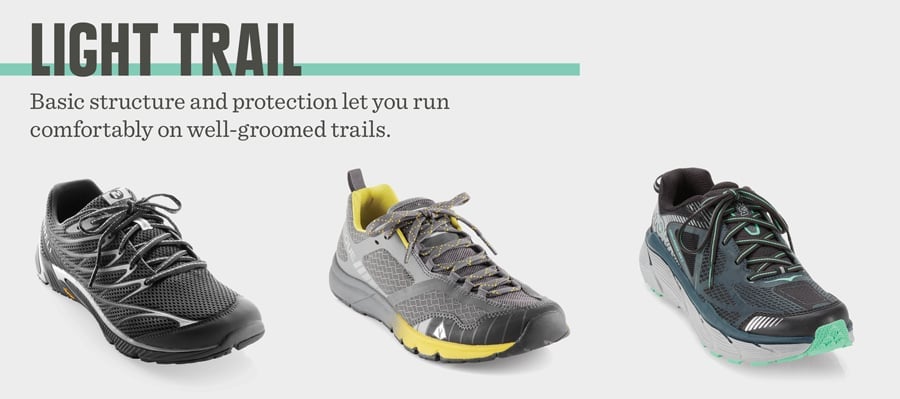
Light Trail
Light trail shoes are designed for relatively uniform surfaces like fire roads, gravel paths and well-maintained hiking trails. Shoes in this category are most similar in design and construction to their road running relatives. Characteristics of light trail shoes include:
Lightweight construction
Modest protection from rocks and roots
Moderate stiffness for stability while maintaining some flexibility for comfort
Outsoles designed for good grip on packed dirt and gravel with shallow, tightly spaced lugs
Shop our pick for best light-trail running shoe of 2025: On Cloudsurfer Trail
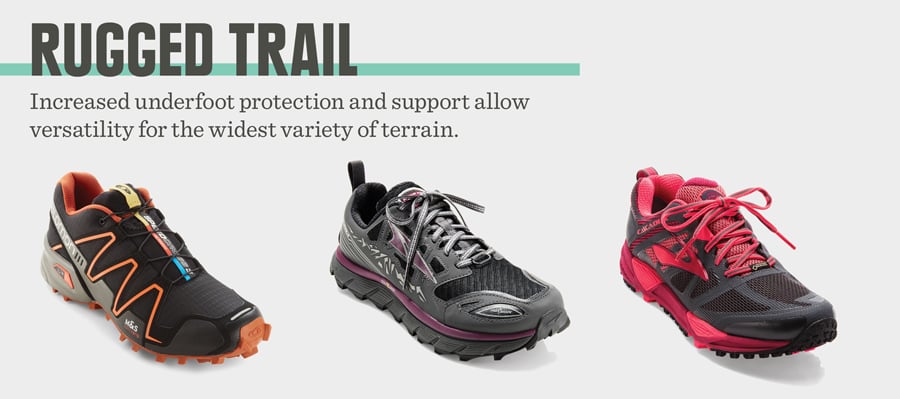
Rugged Trail
Rugged trail shoes are essentially meant for running on hiking trails, which can range from smooth, clear and gentle to rough, technical and vertiginous. This category covers the widest range of shoe designs and offers the most variety of choices. In rugged trail shoes, you’re likely to see:
More protective features in the upper and midsole designed to prevent your feet from getting beaten up
More durable materials to handle additional wear and tear
Increased emphasis on stability features in both the upper and midsole to help you maintain footing when the going gets rough
Deeper, grippier and more widely spaced lugs for traction on loose, muddy or sloppy trails
Shop our pick for best rugged-trail running shoe of 2025: Salomon Thundercross
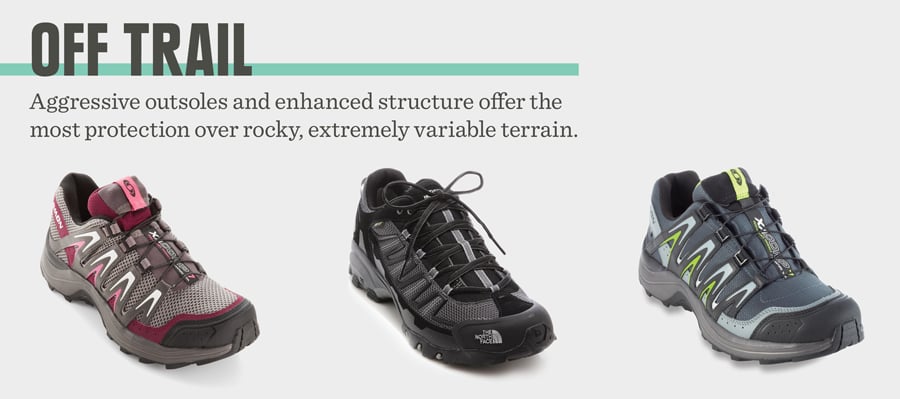
Off Trail
If you’re thinking less “trail running” and more “mountain running,” off trail shoes may be just the ticket. Off trail running shoes take all the same basic design elements of rugged trail shoes and kick it up a notch with:
Extra-rugged materials that provide durability needed when leaving the beaten path behind
Additional structure in the upper and midsole for more rigidity, stability and protection when it counts the most
Super-grippy rubber outsoles and deep, widely spaced lugs for traction on rock slabs
Shop our pick for best off-trail running shoe of 2025: HOKA Mafate Speed 4
Buying trail runners for hiking, backpacking or thru hiking: Some hikers do this to save weight. That's OK, but be prepared to replace them often. Whether you find them more or less comfortable will depend on pack weight, trail ruggedness and foot toughness. If you decide to do it, look at off-trail models because they offer more durability and support than rugged-trail or light-trail shoes.
Trail-Running Shoes Uppers
A trail shoe’s upper—the top part of the shoe where the laces are—has two main jobs: to protect your foot and to hold it securely in place. Uppers designed for use on light trails will feel most similar to road-running shoes. They often prioritize lightness, breathability, flexibility and comfort over more protective features.
Uppers designed to tackle rugged terrain use more durable materials and additional structural elements—both to protect your feet and the shoe. Uppers on some rugged-trail and off-trail shoes may even incorporate Dyneema® or Kevlar—materials with incredibly high strength-to-weight ratios—to ensure both your feet and your shoes make it through your run unscathed. For shoes with top-notch rugged uppers, shop the norda 001 or 002 and Salomon S/Lab Genesis.
Features you may find on trail-running shoe uppers include:
Toe caps are rubber bumpers at the front of the shoe that offer protection against stubbed toes. Whether you’re just starting out or you’ve been trail running for years, accidentally kicking rocks and roots is a fact of trail running life.
Shoes designed for light trails with fewer obstacles may have little more than a small piece of rubber at the tip of the shoe. This style offers protection from minor bumps while keeping the shoe lighter and improving breathability.
Toe caps on shoes designed to handle rougher trail conditions will cover more of the front of the shoe, and may even wrap around the sides for maximum protection. While this style adds some weight, your toes will thank you when the going gets tough.
Gusseted tongues connect to the upper on the front of the shoe and also around the sides. This gusset—the fabric that connects the tongue to the upper—prevents debris from getting into the shoe and keeps the tongue in place. Some gussets wrap all the way around the foot to ensure an extra-secure fit; an especially valuable feature on rocky, technical trails.
Waterproof and water-resistant uppers are great for rainy, cold-weather trail running. Fully waterproof trail shoes incorporate a waterproof/breathable liner that prevents water from making it to your foot while also allowing some sweat out of the shoe in the form of water vapor.
Many shoe brands use GORE-TEX® technology like that found in rain jackets, while others use their own version of a waterproof membrane.
Water-resistant uppers use tightly woven mesh and/or strategically placed rubber to minimize the amount of water that makes it into the shoe. Water-resistant uppers will generally be more breathable than fully waterproof shoes.
Be aware that in addition to keeping water out, waterproof running shoes also keep heat in. This extra insulation may be a boon on cold days, but can cause issues when the temperature climbs. Read Should I Get Waterproof Trail-Running Shoes to learn more.
Trail-Running Shoe Midsoles
The midsole provides a trail shoe’s feel, or ride, but it’s also where you’ll find the shoe’s stability and protective features. Here are some things to consider when choosing a trail-running shoe midsole:
Rock Plates and Guards
Many rugged- and off-trail shoes feature rock plates in their midsoles. These plates, made of thin plastic or carbon fiber, sometimes run the length of the shoe while others are found only in specific areas like under the forefoot.
In addition to protecting your feet from sharp rocks and roots, full-length rock plates add torsional rigidity to trail-running shoes, meaning that you’re less likely to twist if you land awkwardly on an uneven surface. Having a shoe that mostly holds your foot in the same plane rather than letting it twist or roll easily is especially useful on technical trails where most of the trail surface is uneven.
Plastic rock plates are the less expensive and more common option, while lighter weight, stiffer carbon fiber plates are reserved for more expensive shoes, like those designed for race day.
Cushion
The amount of cushioning in a shoe, also known as its stack height, falls into one of three categories:
Barefoot or minimal cushion: While no firm guidelines exist, most barefoot shoe midsoles are made of thin rubber. Minimalist shoes might have up to around 20 mm of foam in their midsole. Fans of minimalist shoes appreciate feeling connected to the trail, and some say that they encourage a more natural running gait. These shoes are usually very lightweight and inherently stable thanks to being so close to the ground. Because they offer little by way of support or protection, most shoes in this category are designed to handle light trails. If you’re not used to them, switching to this style of shoe takes time and patience. Learn more about Minimalist/Barefoot Running Basics.
Moderate cushion: Shoes with a moderate stack height, up to around 30 mm, are traditional trail-running shoes. They offer more support and protection than minimalist shoes but without the extra weight and bulk of maximalist models.
Maximum cushion: With anywhere from 34 mm to 40+ mm of foam underfoot, max cushion shoes deserve their name. Proponents of this style appreciate the extra protection and the feeling of “float” provided by such imposing midsoles, especially over long-distance trail runs.
The tradeoffs of running on so much foam include the added weight and bulk, and the decreased stability that comes with being so high off the ground. Some max cushion shoes improve stability by using firmer foam—widening the base of the shoe, or wrapping the midsole higher up the sides of the shoe to help cradle the foot.
It’s important to note that cushion and softness are not necessarily correlated. You can find a maximum-cushion trail shoe with firm foam, or a moderate-cushion shoe with pillowy-soft foam. To learn more about your foam options, read How to Choose Running Shoes.
Understanding Drop

The difference in stack height between the heel and the toe of a shoe, measured in millimeters, is known as drop, or offset. Drop primarily affects how your foot strikes the ground.
Shoes with a high drop, more than 8 mm, will encourage a heel strike (landing first on the heel before rolling through to toe-off), thanks to the extra weight and cushion in the heel.
Shoes with a moderate drop—somewhere between 5 and 8 mm—are versatile options; they work well for everything from heel striking to midfoot and forefoot striking. Most trail-running shoes fit into this category.
Low-drop shoes, anything 4 mm or fewer, are best for midfoot and forefoot strikers.
Zero-drop shoes have the same amount of cushioning in both the heel and the toes. Like low-drop shoes, zero-drop shoes encourage midfoot and forefoot striking.
Because the uneven terrain of trail running necessitates a more varied stride, trail-running shoes generally feature a lower drop. This allows them to accommodate a wider range of foot strikes than road-running shoes.
While different types of foot strikes have gone in and out of style, there is no one ideal way for your foot to hit the ground. Your best bet is to run the way that feels most natural to you, and to choose a shoe with the amount of drop that doesn’t interfere with your normal gait.
The amount of drop and the amount of cushion in a shoe are not necessarily related. Both low- and zero-drop shoes are available in a range of cushioning options, from minimal to maximum.
Keep in mind that running in low- and zero-drop shoes may increase the impact on your Achilles tendon, so you’ll want to transition slowly, especially if you’re used to running in high-drop shoes. Read How to Choose Barefoot/Minimalist Shoes to learn more.
Video: Running Shoe Midsoles, How Do They Work?
Trail-Running Shoe Outsoles
While all trail-running outsoles provide traction on unpaved surfaces, there are important nuances depending on the kind of trail running they’re designed for.
- Some outsoles are made of firm, durable rubber to maximize both the longevity of the tread and traction on dirt trails.
- Other outsoles use the same kind of soft, sticky rubber used in climbing shoes for extra grip when the going gets rocky. Shoes designed for very technical trails and mountain running often feature climbing-style rubber in their outsoles.
- Some brands make their own outsoles while others use outsoles made by Vibram® which offer unparalleled traction and durability.
Here are some things to consider when choosing a trail-running shoe outsole:
Lug Patterns
Outsoles with shallow, tightly spaced lugs are designed for dry, hard-packed trails and forest roads. This kind of lug pattern offers great grip and a smooth ride on even surfaces, but less traction in muddy or loose conditions. You’re more likely to find shallow, tighter lugs on light trail shoes.
Outsoles with deep, widely spaced lugs are the best choice for wet, loose and muddy trails. The deep lugs dig into the trail, and spacing them out keeps mud and debris from caking onto the shoe. While this outsole design is great for traction, it can feel less comfortable on hard, even surfaces.
Rubber Coverage
Rubber is relatively heavy, so most light trail shoes save weight by using partial-coverage outsoles. These outsoles leave low-wear sections of the midsole, like under the arch or in the center of the heel, exposed. The result is a light, nimble, but still quite durable shoe.
Most rugged trail shoes use full-coverage outsoles. They are heavier, but offer the best traction and durability, especially on rough terrain.
Video: Running Shoe Outsoles Explained
Get a Good Fit
The most important part of choosing trail-running shoes is finding a pair that fits well out of the box with no break-in period needed. Your best bet is to head to your local REI store to try on a few pairs in person. To learn more, read How to Get a Great Fit in Running Shoes.
Here are some things to keep in mind as you shop:
Get both feet measured. Your foot size changes over time, so it's important to get your feet measured when trying on new trail-running shoes.
Be aware of brand fits. Not all shoes are built for all feet. Brands have their own proprietary foot model, or "last," that they design their shoes around. Some may be wider through the midfoot, others may be narrower in the heel and some may be overall higher in volume to accommodate larger feet.
These idiosyncrasies are something that a footwear specialist will know, which is why an in-store fit session is key. Once you find out which brands use a last that’s similar to your foot, you can shop online and have a better chance of selecting shoes that fit.
Foot shape vs. your foot’s shape. More brands like Altra and Topo Athletic make shoes with added room in the toebox to let your toes splay out with each step, something often described as a “foot shaped” fit. Proponents of these wider toeboxes say that they offer a more comfortable fit and a more natural way to run.
For those with narrower feet, however, the extra room may cause issues like blisters or hot spots from toes sliding around. They might also feel less nimble on technical trails than shoes with a narrower toebox. Finding a good fit often comes down to personal preference, so try on a variety of styles before choosing one.
Consider your foot’s width. Some brands make their shoes in both “regular” and “wide” versions. If you feel like you have to squeeze into standard-width shoes, it’s worth looking into wide trail-running shoes.
Try on both shoes: Some people have one foot that’s larger. Try on both the right and the left shoe, and choose the pair that fits your larger foot.
Try on shoes at the end of the day: Your feet swell throughout the day and will be largest at the end of the day. This tactic helps you avoid buying shoes that will end up feeling too small.
Aim for a thumbnail's length of space in the toebox: You should be able to wiggle your toes. The width should be snug but allow a bit of room for your foot to move without rubbing. Laces should be snug but not tight.
Bring along insoles, running socks or orthotics (if you use them): They affect the way your shoe fits.
Lace your shoes correctly: Certain lacing techniques can improve the fit of your shoes. The runner's loop, for example, can help lock your heel in place. Window lacing (box lacing) can help relieve pressure points on the top of your foot. Read How to Lace Running Shoes.
Ready to buy? Shop our picks for Best Trail-Running Shoes of 2025. For more gear, check out our list of Trail-Running Essentials.
Video: How to Size and Fit Running Shoes
Running Shoe Length and Width Size Charts
Measure the length and width of your feet using the tips in the video above, then consult with these size charts to find your perfect fit.
Women's Running Shoe Length Size Chart
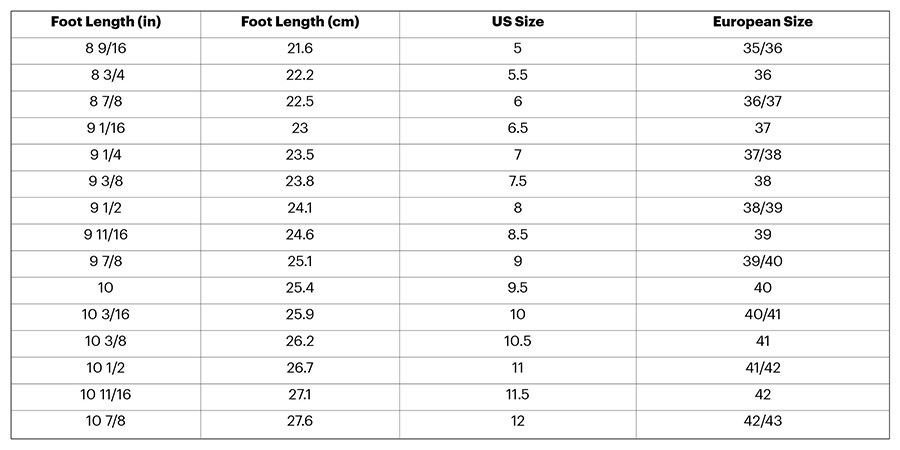
Men's Running Shoe Length Size Chart
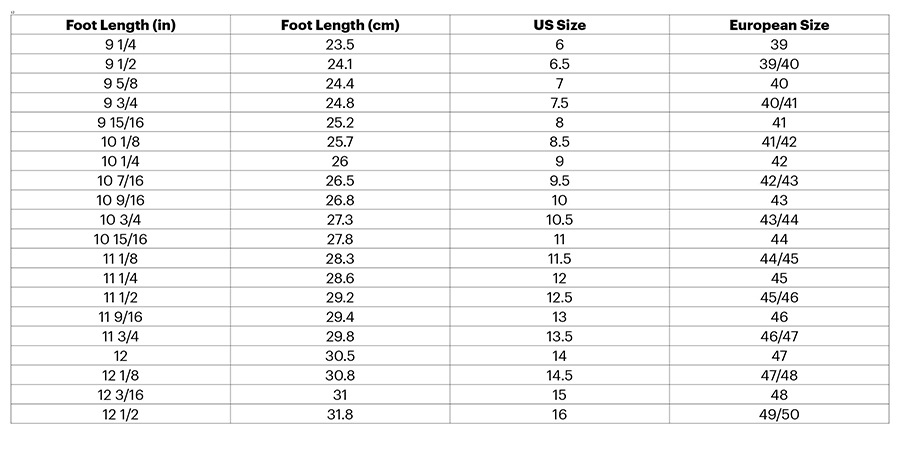
Women's Running Shoe Width Size Chart
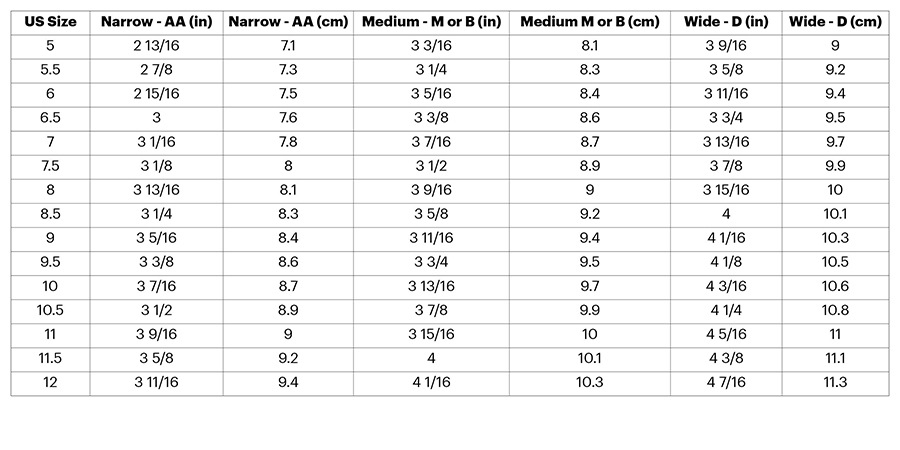
Men's Running Shoe Width Size Chart

Our Experts
Yitka Winn, an REI product copy editor based in Washington, has dozens of trail ultra races under her belt. Highlights include winning Cascade Crest 100 Miler four times and a fifth place finish at Hardrock 100 Endurance Run as well as racing the iconic UTMB (Ultra Trail du Mont Blanc). She’s also the author of Beer Hiking Colorado. When she’s not running or writing, Yitka is likely spending time with her family—hiking, swimming or immersed in a good book.
Jason Boyle, an REI Co-op Member and gear tester based in New Mexico, is a long-time adventure guide with a passion for helping people get outdoors. He has run 55 marathons in 37 states, and is constantly training for the next race—usually while wear-testing a new pair of shoes for Expert Advice.
Alan Ortega, an REI store manager based in California, has been running since he joined the co-op 11 years ago. He’s more often found seeking majestic viewpoints in the mountains than pounding the pavement, though he has completed two road marathons in addition to running the Wonderland Trail at Mount Rainier and the Rim-to-Rim at the Grand Canyon. Alan evaluates running vests by how many applesauce pouches he can fit in the front pockets and shares his apartment with 50 pairs of running shoes.
Braden Van Dragt, a longtime REI contributor based in Washington, has been trail running since he discovered it’s the quickest way to his post-hike burger. He enjoys both ultra and sub-ultra race distances, and since becoming a father he has discovered the joyful pain of road running. His best and worst decision was to race the Boston Marathon followed 3 weeks later by the Miwok 100K. Braden owns the right piece of outdoor gear for any given situation, but he always leaves it at home.
